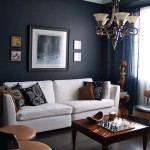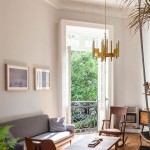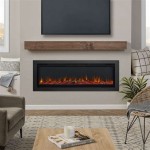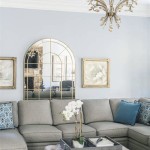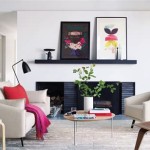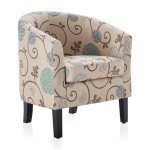Living Room Accent Wall Color Ideas: A Comprehensive Guide
An accent wall, a design strategy employed to highlight a specific wall within a room, can significantly enhance the aesthetic appeal and overall ambiance of a living space. The strategic use of color on an accent wall introduces depth, visual interest, and can even serve to define specific zones within an open-concept layout. The selection of the appropriate color for an accent wall requires careful consideration of existing décor, room size, natural light conditions, and the desired mood or atmosphere.
This article will delve into a variety of accent wall color ideas suitable for living rooms, exploring the principles behind choosing the right color, and providing practical examples to inspire design choices.
Understanding Color Psychology and Its Impact on Living Room Spaces
Color psychology posits that colors can evoke specific emotions and psychological responses. When selecting an accent wall color, it is crucial to understand the potential impact of different hues on the occupants and the overall atmosphere of the living room. Consider these general associations:
Blue: Often associated with calmness, serenity, and stability. Lighter shades of blue can create a relaxing and airy feel, while darker blues can add depth and sophistication.
Green: Linked to nature, growth, and tranquility. Green can bring a sense of freshness and harmony to a living room. Olive green shades project a sense of earthiness and can create a comfortable, inviting atmosphere. Emerald green can add a touch of luxury.
Yellow: Associated with joy, optimism, and energy. Yellow should be used judiciously, as intense shades can be overwhelming. Muted yellows or mustard tones can add warmth and brightness without being overly stimulating.
Red: Associated with passion, energy, and excitement. Red is a bold choice for an accent wall and should be used sparingly. It can create a dramatic and stimulating focal point. Deeper reds, such as burgundy, offer a more sophisticated and less intense option.
Orange: A blend of red and yellow, orange is associated with warmth, enthusiasm, and creativity. Similar to red, orange is a bold color and should be used with caution. Terracotta or burnt orange shades offer a more subdued and earthy feel.
Purple: Associated with royalty, luxury, and creativity. Lighter shades of purple, such as lavender, can create a calming and sophisticated atmosphere. Darker purples, such as eggplant, can add drama and depth.
Neutral Colors (Gray, Beige, White): These colors provide a versatile backdrop that can be easily paired with other colors and textures. They are ideal for creating a calm and sophisticated living room.
When choosing a color, consider the room's overall design scheme and the desired emotional impact. If the goal is to create a relaxing space, blues, greens, or neutral colors may be preferable. If the intention is to create a more stimulating and energetic space, reds, oranges, or yellows could be considered.
Matching Accent Wall Colors with Existing Décor and Room Features
An accent wall should complement, not clash with, the existing décor and architectural features of the living room. Consider the following factors when selecting an accent wall color:
Existing Furniture: The color of the furniture is a primary consideration. The accent wall color should either complement or contrast purposefully with the upholstery and wood tones. For example, if the living room furniture is primarily neutral tones, a bolder color, such as deep teal or a vibrant ochre, can add a pop of visual interest.
Flooring: The color and material of the flooring play a significant role in the overall design scheme. If the flooring is a dark hardwood, lighter accent wall colors, such as a soft gray or muted blue, can help to brighten the space. If the flooring is light-colored, a darker accent wall color can add depth and visual contrast.
Architectural Features: Consider the architectural features of the room, such as fireplaces, built-in shelves, or crown molding. The accent wall can be used to highlight these features. For example, painting the wall behind a fireplace a deep charcoal gray can create a dramatic focal point.
Artwork and Accessories: The colors of the artwork and accessories in the living room should also be considered. The accent wall color should complement these elements, creating a cohesive and harmonious design. For example, if the living room features artwork with blue and green tones, a muted green accent wall can tie the space together.
Lighting: Natural and artificial lighting can significantly impact the appearance of a color. Colors tend to appear brighter in rooms with abundant natural light and darker in rooms with less natural light. It is advisable to test paint samples on the wall under different lighting conditions before making a final decision.
When selecting an accent wall color, take paint samples and compare them to existing furniture, flooring, and accessories. Observe how the colors interact under different lighting conditions to ensure a cohesive and visually appealing result.
Practical Accent Wall Color Ideas and Examples
Here are some practical accent wall color ideas suitable for various living room styles, each designed to create a specific mood and aesthetic:
For a Relaxing and Serene Living Room:
Muted Blue: A soft, calming blue, such as a dusty blue or a light cornflower blue, can create a serene and relaxing atmosphere. This color pairs well with white or light gray furniture and natural wood tones. This creates a coastal theme effect.
Sage Green: A muted, earthy green can bring a sense of tranquility and harmony to a living room. Sage green complements natural materials, such as linen and wood, and can create a cozy and inviting space.
Light Gray: A light gray accent wall can create a sophisticated and calming backdrop for the living room. Light gray works well with a variety of furniture styles and colors and is a versatile choice for creating a neutral and balanced space.
For a Warm and Inviting Living Room:
Terracotta: A warm, earthy terracotta can add a touch of warmth and character to a living room. This color pairs well with neutral furniture and natural textures, such as leather and woven fabrics.
Mustard Yellow: A muted yellow, such as mustard yellow, can add a touch of warmth and brightness to a living room without being overly stimulating. Mustard yellow complements dark wood tones and can create a cozy and inviting atmosphere.
Deep Burgundy: A rich, deep burgundy can add a touch of luxury and sophistication to a living room. Burgundy pairs well with gold accents and dark wood furniture and can create a warm and inviting space.
For a Bold and Dramatic Living Room:
Navy Blue: A deep, saturated navy blue can create a dramatic and sophisticated focal point in the living room. Navy blue pairs well with white or light-colored furniture and gold accents.
Charcoal Gray: A dark charcoal gray can add depth and drama to the living room. Charcoal gray works well with a variety of furniture styles and colors and can create a modern and sophisticated space.
Emerald Green: A vibrant emerald green can add a touch of luxury and glamour to the living room. Emerald green pairs well with gold accents and dark wood furniture.
Geometric Patterns: Instead of a solid color, consider using paint to create a geometric pattern on the accent wall. This can add visual interest and texture to the space. Examples include chevron patterns or large triangles, using contrasting colors for a bold statement.
Ombre Effect: An ombre effect, where the color gradually fades from light to dark, can create a subtle and visually appealing accent wall. This technique works well with a variety of colors and can add depth and dimension to the room.
Textured Paint: Using textured paint can add depth and dimension to the accent wall. There are a variety of textured paints available, ranging from subtle to more pronounced textures. This can be a great way to add visual interest without using a bold color.
These are just a few examples of the many accent wall color ideas that can be implemented in a living room. The key is to consider the existing décor, room features, and desired mood to select a color that complements the space and creates a cohesive and visually appealing design.

Living Room Paint Ideas With Accent Wall Wandfarben Ideen Wohimmer Design Schlafzimmer

15 Best Accent Wall Ideas How To Create An

6 Accent Wall Ideas To Add Character Every Room Beamin Moore

6 Accent Wall Ideas To Add Character Every Room Beamin Moore

Budget Friendly Accent Wall Ideas To Transform Any Room Walls In Living Bedroom Accents

18 Ideas For Designing An Accent Wall Extra Space Storage

How To Choose The Perfect Accent Wall 360 Painting

What Colour Accent Wall Goes With Grey Here Are 6 Options

How To Choose An Accent Wall And Color Options The Artisen

Accent Wall Ideas Diy Home Decor The Cards We Drew

